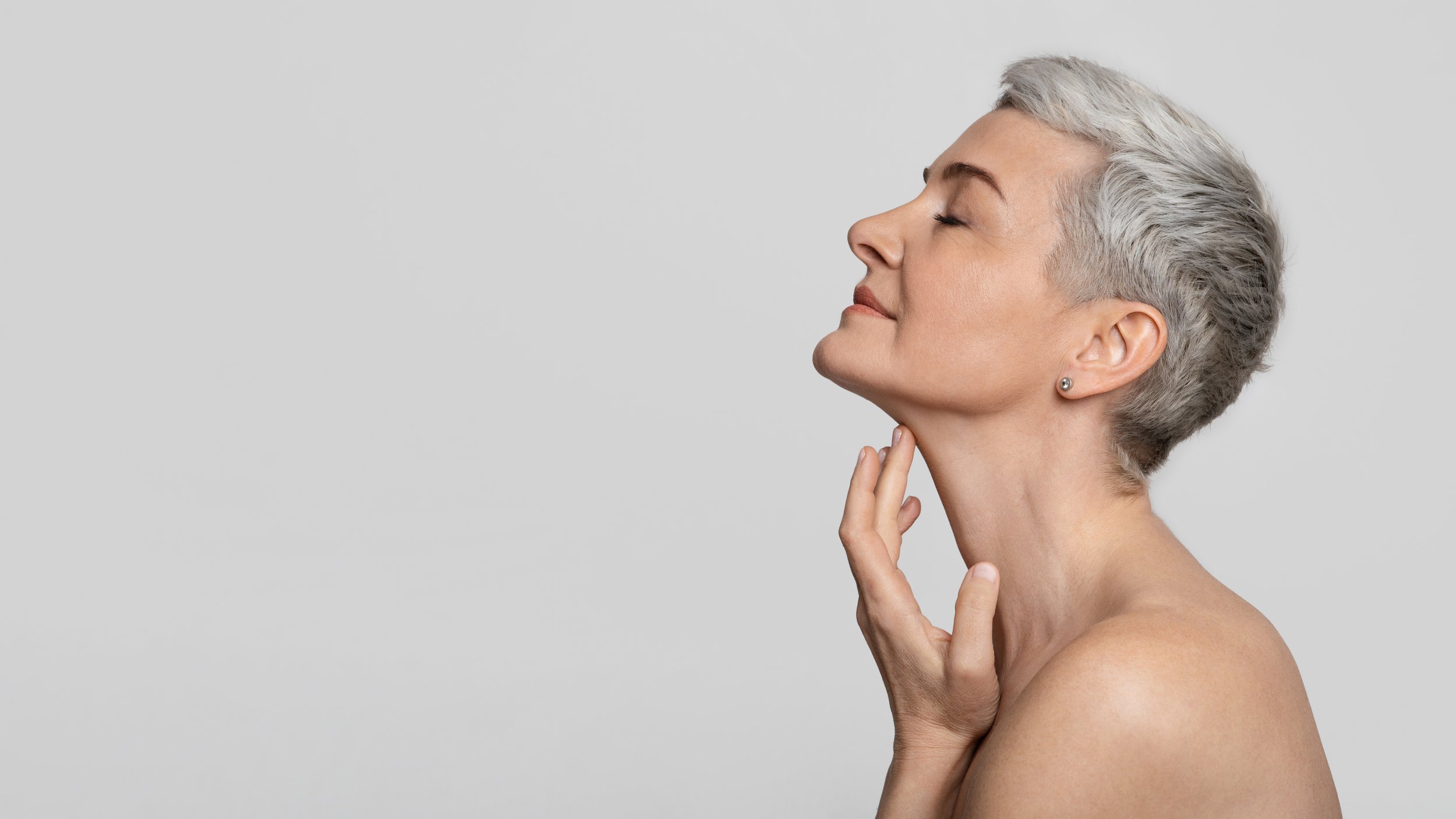
Frequently
Asked
Questions
If you have any questions or you’d like discuss options to achieve your aesthetic goals, book an obligation-free consultation here >
WHAT CAUSES FINE LINES AND WRINKLES?
Fine lines and wrinkles are caused by a combination of factors. Firstly, we have intrinsic aging. As we age, we experience a decrease in collagen and elastin production in our skin, these proteins are essential for maintaining skin elasticity and firmness. This decline in collagen and elastin results in the skin becoming thinner and less able to bounce back. In addition to intrinsic aging, we also have extrinsic factors such as prolonged sun exposure, lifestyle factors like smoking, poor nutrition, dehydration, and environmental pollutants.
When certain facial expressions are made repeatedly, such as squinting, frowning, or smiling, the underlying muscles contract and cause the overlying skin to fold or crease. This is seen quite clearly in the frown area, crow’s feet and forehead – all very visible signs of ageing. Initially, these creases are temporary and disappear once the muscles relax. However, with age and decreased skin elasticity, these creases become more permanent, leading to the development of fine lines and wrinkles. Additionally, as collagen and elastin production decline with age, the skin becomes less able to bounce back from these repetitive movements, further contributing to the formation of wrinkles.
If the development of wrinkles in the crow’s feet, frown lines or forehead are concerning you, why not book a consultation to discuss what treatments may be available to help reduce these visible signs of ageing. BOOK NOW
WHAT CAUSES FACIAL VOLUME LOSS?
Facial volume loss occurs as a natural part of the aging process and involves a combination of factors. One key factor is the gradual loss of fat pads beneath the skin, particularly in the cheeks, temples, and around the eyes, which leads to a loss of volume and fullness in these areas. Additionally, there is a decline in collagen and elastin production, which are essential proteins for maintaining skin elasticity and firmness. As a result, the skin becomes thinner and less able to support the underlying structures, contributing to a sunken or hollow appearance. Other factors such as genetics, lifestyle habits, and environmental exposures can also influence the rate and extent of facial volume loss.
In addition to fat pad depletion and decreased collagen and elastin production, another significant factor contributing to facial volume loss as we age is bone reabsorption. Over time, there is a gradual reduction in bone density and volume in the facial skeleton. This process, known as bone reabsorption, can lead to changes in facial structure and proportions, including a loss of support for the overlying soft tissues. As a result, the skin may appear less firm, and certain areas of the face may appear sunken or hollow. Bone reabsorption can particularly affect areas such as the jawline, chin and tear troughs, contributing to changes in facial contour and overall appearance.
If volume loss in the cheeks, jawline, tear troughs or lips are concerning you, why not book a consultation to discuss what treatments may be available to help reduce these visible signs of ageing. BOOK NOW
WHAT CAUSES THINNING LIPS?
Who doesn’t dream of luscious, full and hydrated lips?
As we age, our lips naturally lose volume and moisture due to a decrease in collagen and elastin production. This leads to thinner lips with less defined borders and increased susceptibility to dryness and fine lines.
Genetics will also play a role. Some individuals may have genetically thin lips, characterised by a lack of natural volume and definition. Genetics play a significant role in determining lip shape and size, influencing factors such as lip thickness and lip-tooth display.
Environmental factors will also impact the appearance of our lips. Exposure to harsh weather conditions, such as cold temperatures and strong winds, can strip the lips of moisture, leaving them dry, chapped, and prone to dehydration. Additionally, excessive sun exposure can contribute to premature aging of the lips, leading to loss of volume and elasticity.
Certain lifestyle habits, such as smoking and dehydration, can exacerbate lip thinness and dryness. Smoking not only damages the delicate skin of the lips but also accelerates collagen breakdown, leading to premature aging. Dehydration, whether due to inadequate water intake or excessive caffeine consumption, can leave the lips parched and lacking in moisture.
At Kiss and Glow, we offer consultations to discuss the concerns you may have regarding lip volume, hydration, and definition. Our skilled practitioners will work closely with you to develop a personalised treatment plan that enhances your natural beauty and rejuvenates your smile.
WHAT CAUSES SKIN LAXITY AND DEHYDRATION?
As we age, our skin undergoes natural changes that can lead to concerns such as skin laxity and dehydration. These changes are primarily due to a combination of factors including decreased collagen and elastin production, environmental damage, and lifestyle habits.
Collagen and elastin are essential proteins responsible for maintaining the skin's structure, firmness, and elasticity. Over time, the production of these proteins decreases, resulting in a loss of skin firmness and resilience. This reduction in collagen and elastin leads to skin laxity, where the skin may appear loose, saggy, or wrinkled.
Exposure to environmental factors such as UV radiation, pollution, and harsh weather conditions can accelerate the aging process and contribute to skin laxity and dehydration. UV radiation, in particular, damages collagen fibres and impairs the skin's ability to retain moisture, leading to premature aging and increased susceptibility to dryness and dehydration.
Certain lifestyle habits, including smoking, poor nutrition, and inadequate hydration, can also impact skin health and contribute to skin laxity and dehydration. Smoking, for example, damages collagen and elastin fibres, while dehydration can lead to a lack of moisture in the skin, exacerbating dryness and dullness.
Addressing skin laxity and dehydration requires targeted skincare solutions tailored to individual needs. Our clinic offers a range of advanced treatments designed to improve skin elasticity, hydration, and overall appearance. From non-surgical medical treatments procedures to customised skincare regimens, we're dedicated to helping you achieve a smoother, firmer, and more youthful-looking complexion.
Pre- & Post-Care for skin needling
-
Skin needling, also known as micro-needling, is a minimally invasive process whereby a pen-like device containing tiny needles is used to create minute and controlled injury to the skin. This procedure initiates the skin’s natural healing process of tissue rejuvenation and collagen formation. Specialised skin needling performed by a doctor or nurse is considered to be one of the safest skin rejuvenation treatments. Unlike chemical peels, dermabrasion and laser treatments, skin needling causes minimal damage to the skin.
Skin needling is used:
for the reduction in fine lines and wrinkles
to smooth uneven skin tones and pigmentation
to reduce the appearance of scar tissue and stretchmarks
to increase the skin’s natural production of collagen
for the overall health of the skin
For best results, skin needling is recommended once every 4–6 weeks for around 4 treatments.
-
FOR 1 WEEK PRIOR TO TREATMENT, AVOID:
anti-wrinkle injections
prescription topical Retin A
home needling
FOR 2 WEEKS PRIOR TO TREATMENT, AVOID:
waxing, bleaching or hair dying any areas to be treated
depilatory use in any treated area
electrolysis on any treatment area
IPL/laser skin rejuvenation (only prior to very superficial peels)
minimise sun exposure to area to be treated
facial treatments of any kind including any AHA, BHA or Vitamin A treatments
microdermabrasion / epidermal levelling
FOR 4 WEEKS PRIOR TO TREATMENT, AVOID:
IPL/laser skin rejuvenation (only prior to superficial to medium depth peels)
AHA, BHA, Vitamin A or TCA superficial to medium depth peels
in clinic needling
FOR 3–6 MONTHS PRIOR TO TREATMENT, AVOID:
medical needling
fractional ablative laser resurfacing
-
In order to achieve the best results from your professional treatment, we ask that you read and understand the following instructions.
AVOID FOR 24 HOURS:
any skin products other than what you will be provided with post treatment
strictly avoid sun exposure
exercise, spa bath or sauna (avoid getting overheated)

